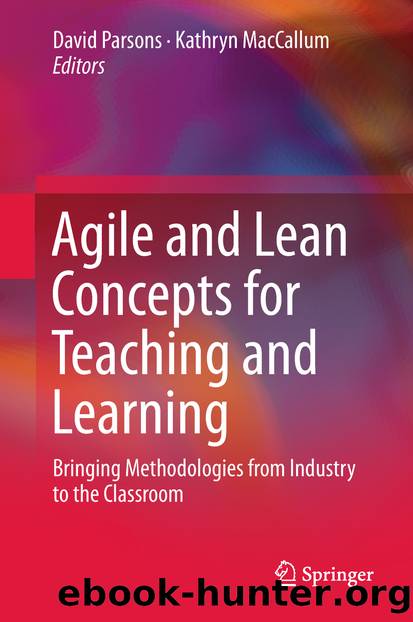Agile and Lean Concepts for Teaching and Learning by Unknown

Author:Unknown
Language: eng
Format: epub
ISBN: 9789811327513
Publisher: Springer Singapore
2 Agile Course Setting
In order to describe how the agile goal setting has been implemented in our introductory programming course, we first describe why the course is needed in our university and who takes it (Sect. 2.1). Next, we define the teaching methods (Sect. 2.2), and the grading scheme enabling the individual learning paths (Sect. 2.3). Finally, the idea of the grading scheme is illustrated with examples of different learning goals (Sect. 2.4).
2.1 Versatile Needs
The overarching learning goal of the Introduction to Programming course in Tampere University of Technology, Finland, is to learn to write small programs on oneâs own. We use Python as the programming language, and in addition to basic computer usage skills, there are no other prerequisites for the course.
The course is obligatory for almost all the students in the whole university, more than 1000 students every year. Consequently, large and heterogeneous student groups are includedâin addition to computer science students, also, for instance, electrical engineering, automation engineering, mechanical engineering, and even material science students take the course. The background for this decision is that in the modern world all graduates need to know at least the basics of programming to better understand the use of computer applications in their own fields.
While computer science students build almost all of their professional skills on top of their ability to program, the students in many other fields just need to understand what programming is. In addition, studentsâ previous programming skills vary greatly: most of the students start with no previous programming knowledge, but the teaching group also includes students who have been programming in high school and in their free time.
The diversity of the teaching group is illustrated in Fig. 1. Students in Group A are majoring in some other field than computer science. Consequently, they only need elementary programming skills. Group B consists of students who start with no prior programming experience and need to cover all the topics of the course. They need to work really hard in this course. Group C consists of students that know the basics prior to the course. Thus, they cope even without special attention from the teacher and are most often neglected in large teaching groups. In our case, all of these students are attending the same course, and hence our goal is to meet the needs of all these student groups in our pedagogical design.
Fig. 1Diverse student population, with special target groups A, B, and C identified
Download
This site does not store any files on its server. We only index and link to content provided by other sites. Please contact the content providers to delete copyright contents if any and email us, we'll remove relevant links or contents immediately.
Time Management Made Easy: How to Cultivate New Habits, Improve Productivity and Get Things Done by Joshua Strachan(2384)
The 7 Habits of Highly Effective People by Stephen R. Covey & Sean Covey(2189)
The Concise Laws of Human Nature by Robert Greene(1779)
Doesn't Hurt to Ask by Trey Gowdy(1588)
Primal Leadership by Daniel Goleman(1198)
Hook Point: How to Stand Out in a 3-Second World by Brendan Kane(1142)
HBR's 10 Must Reads 2021 by unknow(1065)
Don't Sweat the Small Stuff...and It's All Small Stuff by Richard Carlson(1057)
Amazon Unbound by Brad Stone(1000)
100 Things Successful People Do by Nigel Cumberland(984)
HBR's 10 Must Reads 2021 by Harvard Business Review(974)
Master of One by Jordan Raynor(960)
The Job Closer by Steve Dalton(960)
Lives of the Stoics by Ryan Holiday & Stephen Hanselman(923)
Declutter Your Mind: A step by step guide to learn to control your thoughts, stop worrying, relieve anxiety and eliminate panic attacks and negative thinking by Mia Chandler(911)
The Power of 100! by Shaun King(893)
Conflicted by Ian Leslie(826)
Coders at Work: Reflections on the craft of programming by Peter Seibel(810)
The Book of Hope by Jane Goodall(788)
